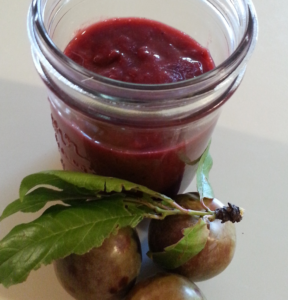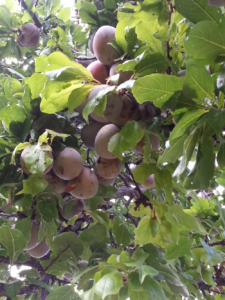Yet more storms and catsup
It rained all night last night, leaving Oak Creek once again Willy Wonka brown. Plus, the water is very high, or at least higher than it’s been since the last flood, which was up to the back of my barn and rerouted the creek to the other side of the island. That’s good, at least according to my neighbors, who really miss their swimming hole. That’s bad for one tiny little turkey poult. The little ones are so small they can go where they shouldn’t. Judging from Mama’s position and the level of her distress, this one must have threaded itself down through the thickest portion of the blackberries–well beyond anyone’s help–to drink from the ditch. I’m thinking that the unexpectedly fast water caught it and swept it away. Mama will stand and call for another hour, then move on with her day. I walked the ditch to the end of my property, just in case. I didn’t find it, but I could have. Turkeys are surprisingly strong paddlers, even at a few days old. It’s possible that it could have made it to shore. The problem is that without feathers, the baby will be cold and once a chick is cold, death is imminent.
I’m looking outside at the clouds building again, and smiling. Why? Well, for sure we needed the rain, but…drum roll please…I happen to be sitting inside IN THE AIR CONDITIONING! Wa-hoo! The new unit was installed today. This required three guys and a trip to the orchard so they could taste the pluots. None of them had heard of the fruit that both my pigs and sheep favor over mere apples. Truth be told, I hadn’t really heard of pluots until I discovered the tree in my orchard. I thought it was a plum at first, because pluots look a lot like the plum-side of their family, but they have a thicker consistency. That comes from the apricot side of their family. That’s right, pluots are a plum-apricot hybrid.
When I first arrived here, the two ancient apples and the pluot tree were the healthiest looking of the seven surviving trees in my incredibly poorly situated orchard. That’s not saying much because there were more dead than live branches in the “healthy” trees. Someone must have had some sort of plan behind putting these trees where they are but I sure as heck can’t imagine what it was. I mean, it’s the only area on the property without access to flood irrigation. Maybe Old Sam Frey figured the sort-of drip irrigation system he installed was enough. Not. Absent owners make for failed systems, and that’s what happened here. To make matters worse, each tree was staked with only one t-post–a metal fence post–driven into the ground right into the tree’s roots. Most of them grew around their stake. So, damaged by the stakes and lacking consistent deep watering, the trees clung to life with nothing but rain to keep them going.
Once I arrived, things changed. I removed the dead trees and severely pruned those who showed even the slightest tendency toward staying with me. Except for the pluot. So many of its inner branches were dead and the aphid infestation was so bad, I didn’t dare remove anything. I actually expected it to die.
Instead, consistent water was all it took. That plucky little tree set on fruit like crazy that summer (my second summer owning the house). There was so much fruit, I didn’t know what to do with it all. That’s when I discovered the recipe for Plum Catsup. I figured pluots were close enough, so I made the recipe. OMG! It was amazing…sweet-sour-tart and sauce-y.
I didn’t make enough. So that next spring I waited with bated breath only to be disappointed. The tree took a break from producing fruit that year (as apricots are wont to do). For that entire summer it listless, suffering with aphids and leaf curl. Disappointed, I waited, hoping the aphid eaters would eventually show up. And so they did. There was some fruit again the following year, but no time for making catsup. Then the next year, to my surprise, there was fruit again although not much. I made my catsup but made it in one big batch (that’s the problem with having really large pots–you tend to think you can make really big batches via simple multiplication). It was a bad idea. Mathmetically, I was supposed to use six 2 inch long cinnamon sticks. That was too much and I ruined the whole batch. Know your cinnamon sticks. Some are really strong!
I didn’t expect any fruit last year, but I was wrong to the tune of gallons. Unfortunately, they all ripened at the exact same moment that I began my adventure as a single sixty-year-old. So the fruit went off to farmers markets and to any neighbor who even cocked an eyebrow at me when I mentioned I had extra fruit. That left me watching and hoping for a crop this year. I got it! Apparently keeping the cows in the orchard over the winter was a good idea. The tree has flourished so well that I’m almost ready to cut out that dead central branch. And, I’m picking fruit by the five-gallon bucket, then hitting the kitchen to make catsup. Small batches this time, so I can control the cinnamon.
 What do you do with Pluot Catsup? It makes a great barbeque sauce, or as a dip for cooked chicken and turkey meat. Personally, I think it truly shines as a topping for meatloaf, especially turkey meatloaf. Derek, my renter, suggests it would be awesome on cheesecake as well, but I’m not a cheesecake eater so someone else will have to try that. Oh, and did I mention it’s the most amazing shade of hot pink? That some stuff!
What do you do with Pluot Catsup? It makes a great barbeque sauce, or as a dip for cooked chicken and turkey meat. Personally, I think it truly shines as a topping for meatloaf, especially turkey meatloaf. Derek, my renter, suggests it would be awesome on cheesecake as well, but I’m not a cheesecake eater so someone else will have to try that. Oh, and did I mention it’s the most amazing shade of hot pink? That some stuff!
Plum or Pluot Catsup
- 1-1/2 pds Plums or Pluots, pitted and quartered
- 2 cloves of garlic, minced
- 1/3 cup packed light brown sugar (I use raw cane sugar mixed with organic molasses)
- 1/3 cup Apple Cider Vinegar
- 1/3 cup water
- 1/2 tsp salt
- 1/2 tsp ground ginger
- 1/4 tsp ground allspice
- 1/4 tsp freshly ground black pepper
- 1/8 tsp cayenne pepper (1 small pepper)
- 1 cinnamon stick, 2″ long
Combine all ingredients. Bring to a boil, then lower heat and simmer at medium low 35- 45 minutes, stirring occasionally, until plums are soft. Remove from heat and let cool 10 minutes. Remove cinnamon stick, puree. Fill sterilized glass 1/2 pint jars (that’s basically one serving), wipe rim, fit with canning lid and ring, screwing lid on until it’s almost tight. Stand upright in a pan of boiling water, the level of which is 3 inches higher than the jars and to which 1/4 cup of white vinegar has been added (prevents unsightly crusty build up). Keep water boiling for 10 minutes, remove jars and set them on a cloth-covered counter top. Check for a solid seal after the jars have cooled.

